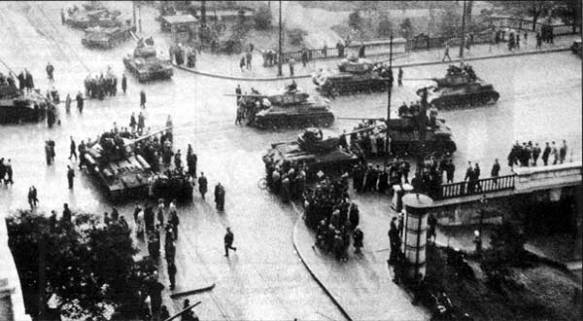
There were riots in East Berlin in June 1953 and in Poznán, Poland, in June 1956, both of which were put down by direct intervention by Soviet troops. These were, however, fairly localized affairs, but the Hungarian revolt in 1956 was a nationwide event, and its brutal repression by the Soviet Union was a turning point for both the Soviet Union and NATO.
Hungary had fought on the German side in the Second World War and was overrun by the Soviet army in 1944. Elections then established a coalition government, but with a substantial Communist minority. The Hungarian Communists then followed a similar pattern to that of their ‘socialist comrades’ in the other satellites and steadily removed their opponents until they won the next elections in 1949, principally because there were no other candidates. The Communists, headed by Secretary-General Mátyás Rákosi, then implemented the usual policies of collectivization of farms and rapid expansion of industry, thus sowing the seeds for their ultimate defeat.
In the aftermath of Stalin’s death in 1953 Rákosi was instructed by the Soviet leadership to install Imre Nagy as prime minister, but after a short period in office Nagy suffered a heart attack in 1955 and had to be replaced.
The situation in Hungary deteriorated rapidly in early 1956, largely due to a general feeling of discontent with Communist rule, to which there were four contributory factors. First, there was a widespread feeling that the leadership itself was irresolute and uncertain as to the way forward, and Hungarian dissidents had taken heart from a visit by Soviet leaders to Yugoslavia in June 1955, which appeared to accord an air of respectability to Tito’s form of nationalist Communism, independent of Soviet control, and from Khrushchev’s de-Stalinization initiative in January 1956. Second, due to the ineptitude so frequently displayed by Communist regimes, the economy was manifestly failing. Third, Soviet armed suppression of the Polish revolt in Poznań encouraged Rákosi to take even more repressive measures in Hungary, but a visit to Budapest by Soviet Politburo member Anastas Mikoyan in July 1956 resulted in a shake-up of the government, with the deeply hated Rákosi being dismissed and replaced by Erno Gero. Finally, even further encouragement to the dissidents came in October 1956, when widespread unrest in Poland resulted in a relatively popular figure, Władysław Gomułka, being released from jail (he had been found guilty of ‘Titoism’) and appointed as first secretary.
This was taken as a signal that a national form of Communism would be acceptable to the Soviet leadership, and a student rally in Budapest on 22 October produced a fourteen-point manifesto demanding a similar system for Hungary. Next day a rally in support of the Poles started peacefully but got out of hand in the evening when an aggressive speech on the radio by Rákosi led to a confrontation between the crowd and the AVH (state security police), who eventually shot into the crowd.
Revolutionary councils immediately sprang up all over the country, advocating three policies: nationalism, neutrality and the withdrawal of Soviet troops. The Soviet leadership, which regarded Hungary as an essential element of its defensive strategy, was alarmed, while the Hungarian Politburo tried to cover all eventualities by calling for Soviet troops and also reappointing the ailing Nagy as prime minister, even though he was opposed to Soviet intervention. When the Soviet tanks began to roll into Budapest in the early hours of 24 October they only made matters much worse, and a number were quickly destroyed by petrol bombs. Two representatives of the Soviet Politburo, Mikoyan and Mikhail Suslov, visited Budapest on 24–26 October and swept the Communist old guard aside, confirming Nagy’s appointment and replacing Gero by János Kádár. Nagy announced his new government on 27 October, the Soviet tanks left on 29 October, and Mikoyan and Suslov returned to Budapest on the 30th to announce that Hungarian sovereignty would be respected.
This Soviet activity was in reality an elaborate camouflage, however, and military forces were massing for the invasion. But at this point external events intervened. On 29 October the Israelis attacked Egypt, and the British and French governments issued an ultimatum to the two sides to withdraw from the Suez Canal and sent an amphibious task force from Cyprus and Malta (30 October). This diverted world attention from events in Hungary, and the Soviet army used some 250,000 troops and 2,500 armoured vehicles to surround Budapest on 1 November. After apparently granting concessions (whose only purpose was to give its troops time to ‘shake out’ into battle order), the Soviet Union struck at midnight on 3/4 November.
Budapest then became a violent and bloody battlefield as Hungarian freedom fighters tried to destroy the Soviet tanks and to kill or demoralize the Soviet troops. But, despite showing great courage and exhibiting considerable ingenuity in their methods of attack, the Hungarians were slowly but inexorably beaten by the organized might of the Soviet army. The main fighting was over by 14 November, and all resistance had crumbled by 30 November. About 25,000 Hungarians and 7,000 Soviet soldiers had been killed in the fighting, but the result was a foregone conclusion.